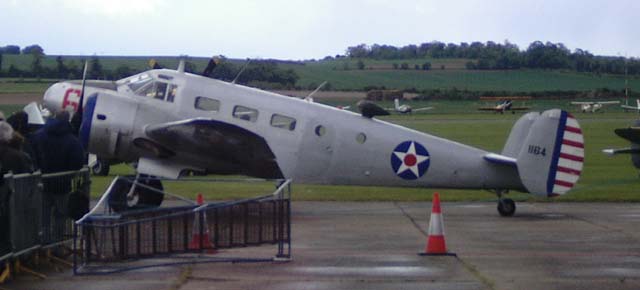 |
Several thousand examples of the Beech C-45
Expediter light transport were used by the US and Allied forces
during the second world war. Its two 450hp Pratt & Whitney Wasp
Junior engines gave it a top speed of just over 200mph and a range
of 1,400 miles. It normally carried seven passengers plus 2 crew.
This one is kept airworthy and was seen on a wet
day at Duxford in May 2005. |
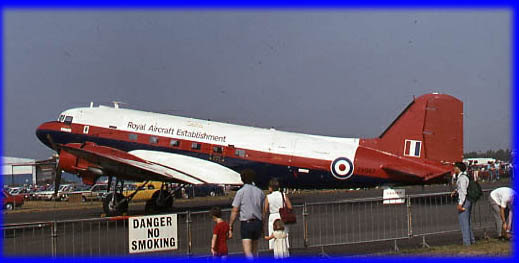 |
The Douglas C-47 Skytrain (known to the Royal
Air Force as the Dakota) was the world's most prolific transport
aircraft. Apart from civil aircraft built from 1935 onwards, over
ten thousand were built for various air forces in the second world
war. Its rugged reliability and ease of operation made it a firm
favourite with commercial operators afterwards, and some are even in
commercial service in the 21st century. Normal accommodation was 28
people, though with a payload of 12,000 lb more could be carried
when necessary. This very smart Dakota
of the Royal Aircraft Establishment was at Bournemouth in August
1984. |
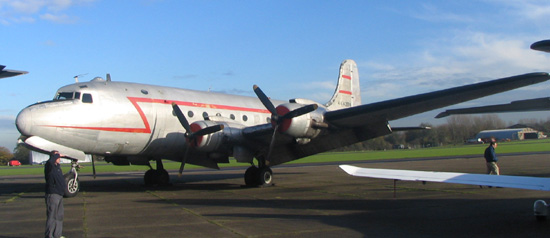 |
The Douglas C-54 (civil designation DC-4) was
originally developed in 1938 as a 52 seat commercial transport. It
saw widespread service during the second world war with the USAAF,
or with the Navy (who designated it R5D). Powered by four 1,350hp
Pratt & Whitney Twin Wasp radial engines, it had a maximum speed of
275mph and range of 3,900 miles. Length was 93 feet 10 inches and
wing span 117 feet 6 inches. 1,245 of all versions were built.
This one was at North Weald in December 2005. |
 |
The Fairchild C-119 Flying Boxcar was a
development of the C-84 Packet, which was just too late to enter
service in the second world war. It had twin tail booms to
facilitate using the rear loading doors for large cargo and
paratroops. It was powered by two huge Wright Cyclone radial engines
and has a payload of 20,000 lb. Very few
survive. This one was seen on a very wet and gloomy day at Manston
in November 1982. |
|
|
The Lockheed C-130 Hercules has become the
benchmark military transport worldwide since it first flew in 1954.
Several thousand of many versions have been built, including some
for unusual special missions such as water bombing as
an airborne firefighter. It is powered by four General Electric T56
turboprops, which give it a top speed of 340mph over a range of
2,450 miles. The top picture shows a
C-130H of the Hellenic Air Force at Fairford, July 2007. Note the
picture of Hercules slaying the Nemean Lion on the tail! The lower picture shows a
C-130J, modified and updated in the early 2000s, at Fairford in July 2005. |
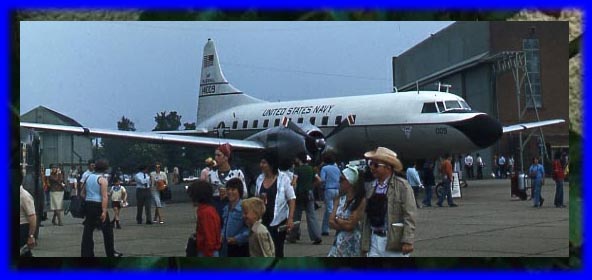 |
Though entering service later than the
Hercules, the Convair C-131 Samaritan was an older technology
transport. They were a military development of the Convair 240 & 340
series of airliners, and were widely used by the US forces as troop
transports until the early 1980s. This
one was at Mildenhall in May 1977. |
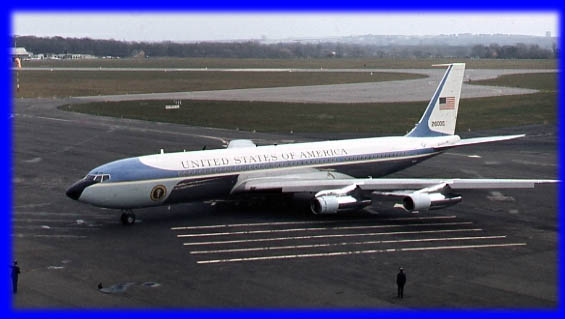 |
The Boeing VC-137 was a converted Boeing 707
commercial airliner, used by the President of the USA as his
personal transport and known worldwide as `Air Force One'. There
were in fact two of them, so there was always a spare!
This one visited Newcastle in 1977, bringing then
US President Jimmy Carter on a visit to the North-East of England.
|
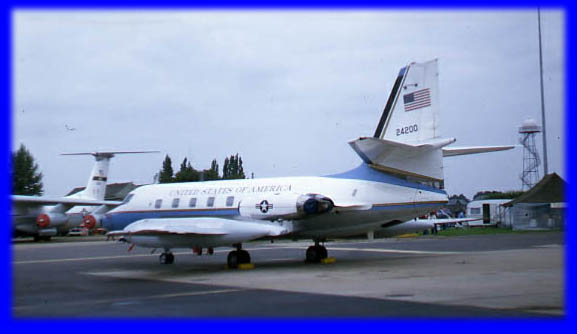 |
The Lockheed C-140 JetStar was a commercial
executive jet, converted for use as a transport for senior officers.
It is unusual for such a relatively small aircraft in having four
engines, making it very safe but quite thirsty: hence the huge
bullet-shaped fuel tanks carried in the middle of the wings.
This one visited Mildenhall in August 1980. |
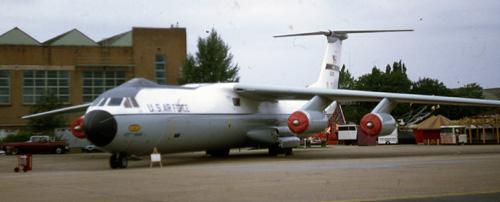 |
This very weak photograph is the best I could
find of a Lockheed C-141 Starlifter. Designed as a very long range
strategic freighter, it first flew in 1964 and was the USAF's first
pure jet freighter. 285 were built. They can take 150 troops or
70,000lb of equipment for over 4,000 miles. Structural problems in
the late 1970s were solved, and at the same time many were converted
into stretched C-141B configuration.
This one was at the Greenham Common air show in June 1981. |
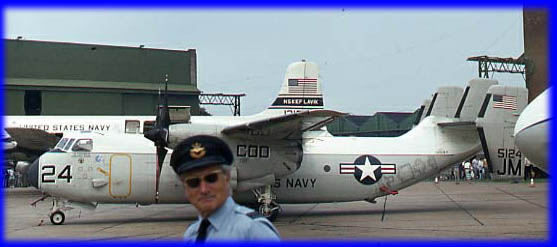 |
The Grumman C-2 Greyhound was designed
specifically for the `carrier on-board delivery' (COD) role, as a
replacement for the C-1 Trader. Its mission is to ferry essential
equipment and personnel onto aircraft carriers at sea. The bizarre
tail configuration is to give it extra lateral stability at low
speed and high weight on approaches to a pitching aircraft carrier
deck.
This one was at Mildenhall in June 1984. Note
also the C-118 in the background. |
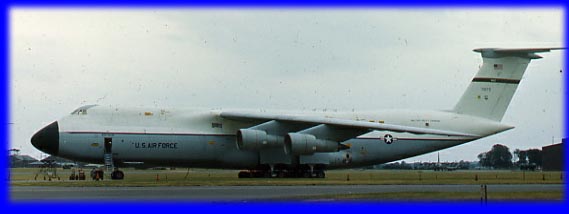
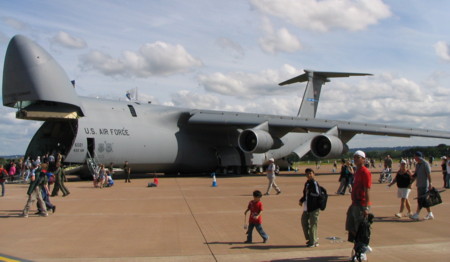 |
When the Lockheed C-5 Galaxy first flew in
1968, it was the world's largest aircraft by some way. It has a
stunning 120 ton payload, and can carry 345 troops for up to 3,000
miles. With lighter loads it can go for 6,500 miles. It is now the
USAF's standard long range heavy transport. It is no longer the
largest aircraft in the world, having been beaten by the Antonov
An124 Ruslan, the An225 Mriya (Dream), and as of 19 January 2005 by
the Airbus A380. |
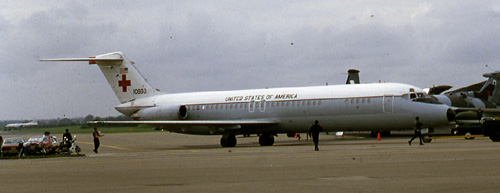 |
The McDonnell Douglas C-9A Nightingale is
basically a civil DC-9 airliner adapted for military service by the
US Navy. It is specially adapted for ambulance flights, and is
equipped to carry up to 40 patients, together with basic life
support services. The Air Force's C-9B Skytrain is a more normal
transport version. Essential statistics are the same as for the
DC9-30 series.
This C-9A was at
Mildenhall, August 1980. |
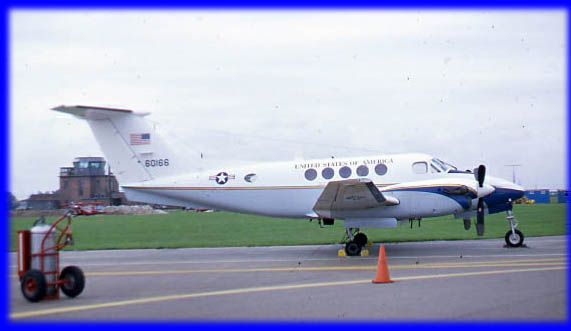 |
The Beech C-12 is the military derivative of
the civil Beech 200 Super Kingair. It is a light liaison aircraft
operated by the US armed forces throughout the world. However, there
are also several special mission variants with various types of
electronic wizardry aboard. Performance is broadly similar to the
earlier Kingair 100. This one was at
Mildenhall in August 1980.
|
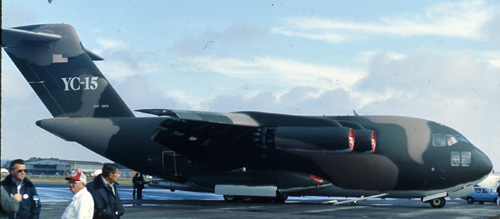 |
The McDonnell Douglas YC-15 competed with the
Boeing YC-14 for the Advanced Medium-range STOL airlifter
competition in the mid 1970s. In the event neither aircraft was
selected and the competition was cancelled. The YC-15 was 124 feet
long, and had a wing span of 132 feet. It first flew in August
1975.its four Pratt & Whitney JT-8D engines (same as the early
DC-9s) developed 16,000lb thrust, and gave it a cruising speed of
540 mph. Gross weight was 217,000lb, of which 62,000 was useful
payload. Note the huge split flaps, which used the airflow from the
engines to generate exceptional lift for STOL operation. Although
the AMST programme itself was cancelled, much of the technology
developed for the YC-15 later found its way to the very much larger
C-17. Farnborough,
September 1976 |
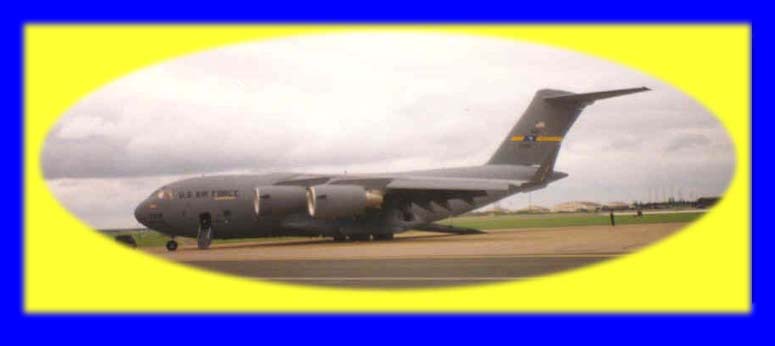 |
The McDonnell Douglas C-17 started to replace
the C-141 Starlifter from the early 1990s. It is optimised for
operation into short, rough, unprepared airstrips with heavy loads.
The fuselage was designed to be able to accommodate most mobile army
equipment, such as tanks and helicopters, without the need for it to
be substantially dismantled. The winglets on the end of the wings
provide extra stability at low speed and reduced drag in higher
speed cruise. This one was at Mildenhall
in the early 1990s (exact date unkown). |
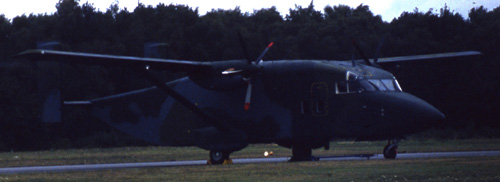 |
The effect of camouflage is graphically
illustrated in this picture of a Short C-23 Sherpa at Farnborough in
September 1984. The C-23 is a militarised version of the SD3-30
feederliner, used to move supplies rapidly between bases in Europe
in the 1980s and early 90s. |
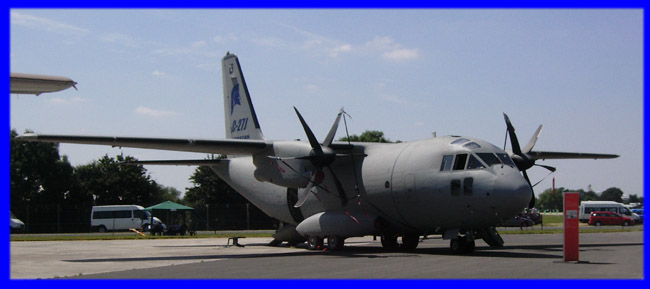 |
Lockheed / Alenia C-27J Spartan: a
development of the Fiat G-222, intended to complement the C-130J
Hercules at the smaller end of the range.
Italian air force example seen at Fairford in
July 2005. |